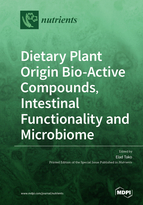Dietary Plant Origin Bio-Active Compounds, Intestinal Functionality and Microbiome
A special issue of Nutrients (ISSN 2072-6643). This special issue belongs to the section "Phytochemicals and Human Health".
Deadline for manuscript submissions: closed (1 September 2020) | Viewed by 60849
Special Issue Editor
Interests: dietary micronutrients; Fe and Zn deficiencies; anemia; Zn status biomarkers; bioactive compounds; prebiotics; microbiome; nutrigenomics; intestinal functionality and development; polyphenols; in vivo models of human nutrition
Special Issues, Collections and Topics in MDPI journals
Special Issue Information
Dear Colleagues,
Plant-based diets contain a plethora of metabolites that may impact on health and disease prevention. Most are focused on the potential bioactivity and nutritional relevance of several classes of phytochemicals, such as polyphenols, flavonoids, carotenoids, phyto-oestrogens, and frucrooligo-saccharides. These compounds are found in fruit, vegetables, and herbs. Daily intakes of some of these compounds may exceed 100 mg. Moreover, intestinal bacterial activity may transform complex compounds such as anthocyanins, procyanidins, and isoflavones into simple phenolic metabolites. The colon is thus a rich source of potentially active phenolic acids that may impact both locally and systemically on gut health. Further, nondigestible fiber (prebiotics) are dietary substrates that selectively promote proliferation and/or activity of health-promoting bacterial populations in the colon. Prebiotics, such as inulin, raffinose, and stachyose, have a proven ability to promote the abundance of intestinal bacterial populations, which may provide additional health benefits to the host. Further, various pulse seed soluble (fiber) extracts are responsible for improving gastrointestinal motility, intestinal functionality and morphology, and mineral absorption. Studies indicated that the consumption of seed origin soluble extracts can upregulate the expression of BBM proteins that contribute for digestion and absorption of nutrients. The soluble extracts can positively affect intestinal health by increasing the mucus production, goblet cells number/diameter, villus surface area, and crypt depth. These functional and morphological effects appears to occur due to the increased motility of the digestive tract, leading to hyperplasia and/or hypertrophy of muscle cells. Plant origin soluble extracts may act, directly or indirectly, as a factor that increases mineral solubility and, therefore, dietary bioavailability. This occurs due to fiber fermentation and bacterial production of SCFA that reduces intestinal pH, inhibits the growth of potentially pathogenic bacterial population and increases the solubility and, therefore, absorption of minerals. The SCFA can increase the proliferation of epithelial cells, which, in return, increase the absorptive surface area, which contributes to the absorption of nutrients. Several phenolic acids and other phytochemicals affect the expression and activity of enzymes involved in the production of inflammatory mediators of pathways thought to be important in the development of gut disorders including colon cancer. However, it is still unclear as to which of these compounds are beneficial to gut health. Hence, the aim of the current Special Issue is to further explore the interactions between dietary plant origin bioactive compounds, their potential effects on the intestinal bacterial populations, and overall intestinal functionality and gut health.
Dr. Elad Tako
Guest Editor
Manuscript Submission Information
Manuscripts should be submitted online at www.mdpi.com by registering and logging in to this website. Once you are registered, click here to go to the submission form. Manuscripts can be submitted until the deadline. All submissions that pass pre-check are peer-reviewed. Accepted papers will be published continuously in the journal (as soon as accepted) and will be listed together on the special issue website. Research articles, review articles as well as short communications are invited. For planned papers, a title and short abstract (about 100 words) can be sent to the Editorial Office for announcement on this website.
Submitted manuscripts should not have been published previously, nor be under consideration for publication elsewhere (except conference proceedings papers). All manuscripts are thoroughly refereed through a single-blind peer-review process. A guide for authors and other relevant information for submission of manuscripts is available on the Instructions for Authors page. Nutrients is an international peer-reviewed open access semimonthly journal published by MDPI.
Please visit the Instructions for Authors page before submitting a manuscript. The Article Processing Charge (APC) for publication in this open access journal is 2900 CHF (Swiss Francs). Submitted papers should be well formatted and use good English. Authors may use MDPI's English editing service prior to publication or during author revisions.
Keywords
- Bioactive compounds
- Fiber
- Prebiotic
- Polyphenols
- Phytochemicals
- Probiotic
- Brush border membrane functionality
- Intestinal microbiome







